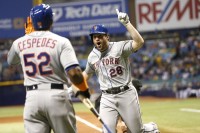Musings
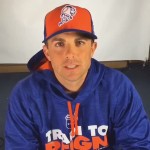
The Mets just completed their first week of Spring Training games, and David Wright never stepped foot on the field. He might not for another two weeks. This is the beginning of what is the new normal for Wright.
This is going to be Wright’s first full season with spinal stenosis. He has to learn how to manage the condition over the course of a full 162 game season. Last season, Wright had difficulty playing three games in a row. He needed several hours just to get ready for one game. All of this is mentally and physically draining. However, there was a benefit to him having to go through it last year. He now knows what to expect and how to manage the spinal stenosis better.
That process began this offseason with more physical therapy for Wright. It meant he started training for the season later than he normally does. It also means he will wait a while before playing in any games. He’s feeling things out.
Wright needs to shorten his pregame routine. He needs to find a way to keep up his stamina so he can handle playing three games or more in a row. He needs to learn when he should sit and when he can go out there and play. He’s learning what his body will permit him to do. In many ways, this is like Wright’s rookie season all over again. He is once again looking to discover if he can play in the major leagues.
The hope is that Wright is healthy and productive when he is able to play. The hope is Wilmer Flores can play well enough to permit Wright to take days off when needed without the Mets worrying how they’ll replace his production. Most of all, the hope is that the Captain will be there ready and physically able to lead the Mets in the postseason to a World Series title.
So if he needs two more weeks, that’s fine. If he can’t play until May, that’s fine too. It’s better to take the time now than rush it and lose him for almost a full season again. The goal here is to have a healthy David Wright in the postseason.
Wright should take all the time he needs.
Editor’s Note: this was first published on metsmerizedonline.com

Last year, the seminal moment of the Spring was David Wright and Bobby Parnell throwing out Noah Syndergaard’s lunch. This year it was Dominic Smith‘s turn to learn a lesson.
This past weekend, Smith got a hold of one, and he thought it was out. He didn’t flip the bat or admire and pose after hitting it. No, he broke right into his homerun trot. He wasn’t hustling out of the box. When the ball hit the wall, Smith wound up with a single instead of a double.
A ten year veteran might get away with it. Not a AA player. It’s why Terry Collins approached him about the moment. For his part, Smith seemed to get it vowing he would never did it again. He said, “there’s no place for me not to hustle out of the box like that. It’s a learning experience.”
Look, this isn’t about taking fun out of the game. He wasn’t chastised for celebrating a homerun. The manager talked to him about a lack of hustle. It was fair for Collins to do so. Smith is a 20 year old kid with a lot of promise. It’s up to Collins in the little time they have together to help point out to Smith what we needs to do to take the next step.
Hustling out of the box is a fair and legitimate concern. It was never an issue for Smith before, and it probably won’t be in the future. However, Collins took advantage of an opportunity to talk to him. Smith will be a better player for it, which is saying something.
Hopefully, this moment will be Thor’s moment. It will be what we will be talking about one day during his rise to greatness.

Well baseball just announced that even though Chase Utley broke Ruben Tejada‘s leg with a tackle, MLB is dropping the suspension:
https://youtube.com/watch?v=-ViF6JRNjTk
Even though Utley made a play no one has ever made before, baseball could find no reason to suspend Utley as “other players weren’t suspended for similar plays.”
https://youtube.com/watch?v=-ViF6JRNjTk
While MLB has stated players making a tackle like Utley did, a play not seen before, MLB said plays like this will be a suspendable offense in the future.
https://youtube.com/watch?v=-ViF6JRNjTk
Despite all evidence to the contrary, Utley doesn’t think his tackle had anything to do with the new rule.
https://youtube.com/watch?v=-ViF6JRNjTk
Utley’s agent stated, “It’s unfortunate that Chase got demonized by all of this. He has never intended to hurt another player.”
https://youtube.com/watch?v=-ViF6JRNjTk
In the same vein, MLB thought it was appropriate to suspend Hansel Robles for losing control of a quick pitch slider, which unfortunately came too close to a batter’s head.
https://youtube.com/watch?v=-ViF6JRNjTk
As a result, it will be fair to say the Mets pitcher who retaliates against Utley will receive a suspension for protecting his teammate.
https://youtube.com/watch?v=-ViF6JRNjTk
Overall, baseball messed up this whole situation from the beginning. Utley should’ve been ruled out. It should’ve been an inning ending double play as Utley interfered with Tejada’s attempt to turn a double play. Baseball then decided that it was reviewable because it couldn’t be a continuation play as Tejada didn’t make a throw. Keep in mind, Tejada couldn’t make a throw because his leg was broken by an illegal tackle.
Even though there was a rule on the books which establishes Utley’s slide was illegal, MLB determined a new rule was needed. Even though Utley’s slide forever changed Tejada’s career, baseball felt the unnecessary rule change was sufficient. There was no need to punish Utley because there was a new rule. Furthermore, even though there was no other tackle like Utley’s baseball determined since no play around second led to suspension before, Utley couldn’t be suspended.
There’s only one way to address how baseball addressed this whole situation is
https://youtube.com/watch?v=-ViF6JRNjTk
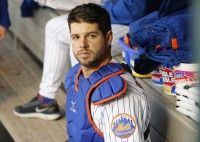
Finally, some common sense. The Mets are now talking about making Johnny Monell the back-up catcher on the Opening Day roster instead of Kevin Plawecki.
Truth be told, Plawecki is the better player right now between him and Monell. However, he’s also still considered a prospect that is going to need to receive regular at bats to get better. Remember Plawecki was a player the Mets believed could’ve challenged Travis d’Arnaud for the starting catcher spot last year. After 2015, it was clear Plawecki has more work to do offensively.
Plawecki was pressed into action when d’Arnaud got injured twice last year. In 73 games, Plawecki hit an ugly .219/.280/.296 with a 3 homeruns and 21 RBI. His OPS+ was a putrid 69, and his 60 wRC+ was just as bad. Yes, the Mets lineup at the time was historically bad, but his numbers show he was a big reason why. Simply put, Plawecki showed he was not ready for big league pitching.
Not to pile on him, but his AAA numbers suggests he shouldn’t have been called up in the first place. In 65 game in Las Vegas, Plawecki only hit .262/.318/.392. These numbers are even more troubling when you consider Cashman Field is a hitter’s park, and the Pacific Coast League is a hitter’s league. However, that’s not reason for concern. It’s reason to believe he just needs more time.
Up until his promotion to AAA in 2014, Plawecki raked. In 58 AA games, Plawecki hit .326/.378/.487 with six homers and 43 RBI. At that point, the Mets got aggressive with him and sent him to AAA where he hit .283/.345/.421 with five homers and 21 RBI in 43 games. It was 2015 when he rwall started to struggle. In the 22 games he played before getting called up to hold the fort for d’Arnaud, he was hitting .224/.267/.341. His hitting woes continued in the majors.
At this point, it should be noted that Plawecki did undergo sinus surgery in the offseason in the hopes it would cure the dizzy spells he experienced during the 2015 season. His dizzy spells could reasonably explain the precipitous drop off in his numbers. It may not. We will see in 2016.
Getting back to the 2016 season, the Mets have an option to make at backup catcher. d’Arnaud is the clear-cut starter. If healthy, he should be an All Star. If healthy, he needs to play as much as reasonably possible. For a catcher, that typically means you get days off in the following situations: (1) day game after a night game; (2) second game of a doubleheader; or (3) game after you caught a long extra inning game. There are other reasons, but those are typically the main ones. With that in mind, absent injury, your starting catcher will typical catch around 130 games.
In a 162 game season, that only leaves Plawecki with 32 games to play. For a player coming off a lost years, that will not help his development. He needs to play and see pitching. He needs to hit. If d’Arnaud gets hurt (again), Plawecki could come up from AAA and start in d’Arnaud’s spot. If Plawecki is then needed he will have been playing everyday, and he will hopefully in a nice groove instead of rotting away on the bench.
Let someone like Monell, who is getting no better, play those 32 games. Monell can hit terribly for those games. He can also prevent Plawecki from accruing service time.
Now, Plawecki is no longer a rookie due to the time he played in the majors last year. He’s also not arbitration eligible. Each day Plawecki is in the majors is another day, he’s closer to arbitration. It’s also another day the Mets lose team control of him. If you’re losing team control of him because he’s actually playing that’s understandable. However, losing control of him so he can play 30-40 games a year as a backup catcher makes no sense. It’s a mismanagement of team assets.
Keeping in the minors permits Plawecki to get the at bats he needs to improve. It also permits the Mets to keep team control. This helps Plawecki, and it helps the Mets. It permits the Mets to have more control for more years if they ever move on from d’Arnaud. It also makes Plawecki a more attractive trade option in the future. His value goes up if a team has more years of control.
In sum, Plawecki being the backup catcher helps no one. It doesn’t help him get better. It also doesn’t help the Mets maximize his value. Monell should be the backup catcher in 2016.
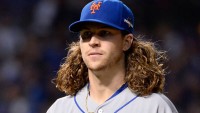
All winter long, Mets fans seemed strangely resolute that neither Noah Syndergaard or Jacob deGrom should cut their hair. Thor had some fun with the fans on the topic:
This offseason neither Thor nor deGrom chopped off their locks. It wouldn’t make sense. Why? As Archie Bunker would say, “The Bible. If you read it, you’d know.”
In the Bible story of Samson and Delilah (Judges 16), we learned that Samson’s great power was due to his hair. Once his hair was chopped, his power was gone. It would lead to his ultimate demise.
As major leaguers say, part of deGrom’s power comes from his hair. Apparently, hitters are having trouble picking up deGrom’s pitches because either they are distracted by his hair or because the hair temporarily hides the ball. With deGrom’s repertoire, the ability to hide the ball, however he does it, makes his pitches all the more dangerous.
I’m not sure if deGrom cutting his hair would lead to his demise. What I do know is that it’s not wise to tempt God. Please don’t cut your hair deGrom.
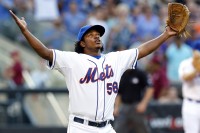
Jenrry Mejia three his entire career away for his continued use of PEDs. At the age of 26, his career is over. It really makes no sense whatsoever.
In an earlier MMO article, different avenues were examined as to the reason why Mejia tested for PED use a third time despite his professed innocence. As part of the analysis, there was the mention of a Latino Sports article wherein Mejia claims he was being that no one was helping him. He said the player’s union abandoned him. He was told that if he appealed the second positive test baseball would suspend him a third time thereby giving Mejia a lifetime suspension.
Mejia has now double-downed on those claims in an exclusive interview with Ben Berkon of the New York Times:
Mejia said that baseball officials told him that if he appealed the punishment for the second doping offense, “they will find a way to find a third positive,” Mejia said through an interpreter. “I felt there was a conspiracy against me. I felt that they were trying to find something to bring me down in my career.”
Naturally, MLB denies these claims.
As for Mejia, who never appealed any of his three steroid suspensions, he will tell anyone who is listening that no one was there to help him save his career:
The association should have done more, Mejia said, adding that he thought the union “should have been there to defend me – because that’s what they’re there for. They should have found something to appeal for.”
It’s interesting that Mejia would continue to profess his innocence while doing nothing to clear his name or toss aside the lifetime suspension. In the NFL, Tom Brady destroyed evidence and took the NFL to court over four games. For his part, Mejia will cry to anyone who will listen.
Overall, while it’s hard to fathom how anyone could have three positive PED tests so close in time, it’s getting harder to fathom how Mejia is the victim of some elaborate conspiracy theory. As more and more times passes, Mejia has substituted actions for words.
Just like Mel Gibson, Flores is certain there’s a Conspiracy Theory. Sooner or later, he’s going to have to settle which one he’s sticking with. Hopefully, like Mel Gibson in the movie, Mejia just disappears forever.

When we talk about the Mets locking up their young pitching, the general consensus is Jacob deGrom is the person most likely to sign an extension before he hits free agency.
For his part, deGrom has said he is open to an extension. He is the oldest pitcher of the group. His agent isn’t Scott Boras. He’s not a local kid who grew up rooting for the Yankees. deGrom seems more affable than a Matt Harvey, so most assume he will re-sign with the Mets at a somewhat discounted rate. Well, today that notion flew out the window:
Statement from Brodie Van Wagenen, Jacob deGrom's agent. pic.twitter.com/6ARbCyaUeb
— Marc Carig (@MarcCarig) March 4, 2016
Let’s not overstate the meaning of this. deGrom thought he was worth more than the $607,500 he is going to be paid next year. He wasn’t going to agree to it, but under the Collective Bargaining Agreement, he had no recourse but to not sign the deal. As is their right, the Mets accepted deGrom’s decision and then told him he was going to be paid that amount whether he liked it or not.
This is not a strain in the relationship between deGrom and the Mets. The only thing that can be gleaned from this is deGrom is not willing to sign an under-value market contract. So what is his market?
The Mets will not have to pay deGrom next year until he hits arbitration as a Super Two player. Judging from Harvey’s first year of arbitration, he will be slated to receive around $4.325 million. If deGrom fights for much more than that, we will all know the type of fight the Mets will have when deGrom gets closer to free agency.
As it stands, deGrom will become a free agent two years after Harvey. When Harvey does become a free agent, it will be around the time the Mets could begin talks with deGrom on an extension to buy out his remaining years of arbitration and a couple of years of his free agency.
When deGrom does hit free agency, he will be 32 years old. If he signs two years prior to free agency, he will be 30 years old. We saw this offseason that 30 year old pitchers can receive massive free agent deals. David Price just signed a 7 year $217 million contract with an opt out after three years. For his part, Zack Greinke, 32, signed a six year $206 million contract. These two pitchers are being paid between $30 – $35 million per year.
Now, deGrom doesn’t have Price’s or Greinke’s credentials . . . yet. deGrom won the Rookie of the Year award in 2014. He was the star at the All Star Game in 2015. He finished Top 10 in Cy Young voting. He had a historic start to the postseason out-dueling Clayton Kershaw in Game One. He then beat the aforementioned Greinke in Game Five. If deGrom continues on this path, he will certainly be worth something in the ballpark of $30 million per year. deGrom’s actions today certainly points to him not wanting anything less than what he thinks he is worth.
Now, on an extension, the Mets can manipulate how much deGrom earns when and try to give him deferred money. However, it is fair to assume deGrom could command close to an average annual value of $30 million per year. As it stands, it appears the Mets will have between $35.5 – $49.5 million to spend on pitching and a bench.
Therefore, as it stands, if deGrom is going to insist on an extension at what he perceives as his value, as is his right, the Mets will have to expand the payroll beyond $140 million to lock up their pitching.
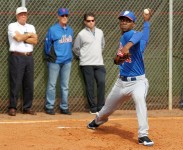
There was a point in time that Rafael Montero was a well regarded prospect. He was once going to force Jacob deGrom into a bullpen role. Now, the only thing we know is the Mets can’t rely upon him right now.
In many ways, 2016 is going to be a make or break year for Montero. Somewhat unfairly the organization turned sour on him last year. He went on the DL in April with shoulder tightness. He was found to have rotator cuff inflammation, which effectively ended his year. In August, he tried to rehab the injury and make some minor league starts, but he again had to be shut down.
This year, Terry Collins wants to challenge Montero as the Mets believe there was really nothing wrong with Montero. Symbolically, the Mets let Montero make the first start in Spring Training on the road against the Nationals.
It didn’t go well. Montero threw 39 pitches in only one inning. He walked four, gave up two hits, and allowed two runs. Not the best of starts. It’s not how he wanted the Spring with the Mets challenging him to be better this year.
At the end of the day, one start shouldn’t mean much. He can go out the rest of Spring Training and pitch very well. He could begin the year in AAA and pitch very well. He could become an injury replacement or spot starter in the rotatio. He could join the bullpen during the year.
There will be opportunities for someone. However, that someone is increasingly becoming someone other than Montero. Last year, Montero was surpassed by Sean Gilmartin and Logan Verrett. They’re likely going to get the first call for spot starts or bullpen work assuming they don’t make come north with the club.
Putting that aside, what was more troubling for Montero was the work of Gabriel Ynoa. He came into the game right after Montero flopped. He threw three scoreless innings and impressed Terry Collins:
Terry Collins says he was very impressed with Gabriel Ynoa today. pic.twitter.com/mSTNgVOFTo
— New York Mets (@Mets) March 3, 2016
Ynoa is a well regarded prospect. He’s ticketed for AAA this year. If yesterday is any indication, it appears that Ynoa is inching past Montero if he hasn’t done so already. While we shouldn’t put too much stock into one Spring Training game, the results today were important. The Mets wanted to challenge Montero to rise to the occasion. Instead, the Mets walked away being impressed with Ynoa.
The problem wasn’t that Montero had a rough outing. The problem is that yet again another Mets pitcher took advantage of an opportunity given to them that was preceded by a Montero failure.
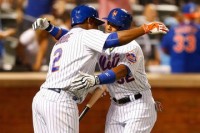
It’s fortunate that the Cleveland Indians Spring Training facility is in Goodyear, Arizona because Yoenis Cespedes seemingly has it out for Juan Uribe:
https://twitter.com/nypost_mets/status/705582411531362305
It’s hilarious that Cespedes would name a pig that’s a champion and name him Uribe. I can think of no more fitting tribute for Uribe. The man has been a part of multiple World Series winning teams, and we saw last year he has the heart of the champion. We also saw over the course of his career that there’s a little more of Uribe to love.
Cespedes naming his pig Uribe shows how much the Mets players loved and respected not just Uribe but each other. It shows that the Mets will miss Uribe, Kelly Johnson, Daniel Murphy, and Michael Cuddyer. That speaks volume not just about those players, but also this team.
Fortunately, a strong clubhouse remains. It’s going to welcome these new players, and they’re going to continue to be a strong tight-knit team that will hit the ground running once the 2016 season officially begins.
I love this team.
